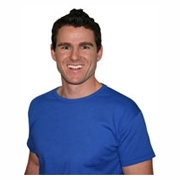Help Clients Avoid Winter Gain
by Matt O'Neil (Nutritionist & Director, SmartShape.com.au)
 As the temperature drops, comfort foods become more attractive. Nutritionist and
As the temperature drops, comfort foods become more attractive. Nutritionist and
fat loss guru Matt O’Neill explains why winter eating habits need special
strategies so you can keep your energy levels up without piling on excess calories.
People tend to eat more in the winter months. Comfort foods like hot chips, muffins,
and chocolate top craving lists and can become harder to resist.
There are many reasons for this trend :
- Cold, wet weather can interrupt your workout routine making it more likely
to reach for comfort foods.
- Reduced daylight hours contribute to winter blues with mood swings triggering
cravings.
- Food companies create greater temptations by advertising more comfort foods.
- You spend more time covered up so your motivation to keep in shape can decrease.
All these factors make it more important for you to manage your appetite in
the colder months.
Appetite awareness
If overeating over winter doesn’t pose a problem because you
easily burn off calories you may simply need to focus on planning your diet
and fine tuning your meal pattern to top up your energy levels throughout the
day.
However, when you’ve got a heavy workout schedule you want to fuel your body with just the right amount of energy, particularly from carbohydrates,but not too much that you end up with excess body fat. Getting better in tune with your hunger and appetite signals can help you get the right balance.
Here are some questions to ask yourself at times you tend to overeat:
Am I really hungry or just am I just bored or stressed?
Particular moods can trigger overeating, so manage these moods first. For example,
keep occupied to reduce boredom or help manage stress by means other than exercise
if you need to. Regular massages are useful here.
Do I overeat when I’m distracted?
If you eat on the run or in front of the television you may consume too much
because you are not listening too your stomach telling you you’re full.
Try to take a break to just eat.
Do I eat too fast?
I call this ‘breaking the feed limit’. Slow down your whole eating
experience. It takes 10-20 minutes from when you start eating for the natural
hormones and chemicals produced by your gut to be recognised by your brain.
Finishing your first course within 10 minutes can have you tucking into seconds
or dessert with calories that you really don’t need.
If you want to feel fuller on fewer calories and still experience the comfort
of a warm winter meal, add soup to your menu. See The Soup Strategy [below/left/right]
for why.
Cutting chocolate cravings
Chocolate cravings can present a specific challenge. A little chocolate
each day (a piece or two rather than a few bars) can be part of a healthful
eating and fitness routine.
But when chocolate cravings get in the way of achieving a healthy diet, it’s
emotional rather than biological triggers, which are likely to need attention.
Becoming aware of eating triggers is a good place to start beating chocolate
cravings.
Write down any triggers for a few days and think about what led to the trigger
and how you could have avoided it. Often it’s planning meals and having
satisfying alternatives to chocolate that help here rather than relying on willpower
alone. Keeping healthier sweet treat foods like tubs of stewed fruit, trim vanilla
custard or your favourite flavoured low-fat yoghurt handy in case of cravings
can help get in way of having chocolate.
When you think you really need chocolate, ask yourself – “Do I need
a lot of chocolate or do I just need a chocolate fix?†A fix of the taste
of chocolate may be all you need for satisfaction.
Try these tips:
- Choose small serves like individually wrapped bit-sized bars, a Freddo
Frog or Milky Way.
- Go for dark chocolate which has a more intense flavour.
- Eat chocolate slowly and savour every bite. You may feel satisfied before
you consume too much.
And for perhaps the ideal warming winter alternative to straight chocolate try
a diet hot-chocolate drink. By implementing these strategies you’ll be
able to maintain your energy levels in the right balance year round.
The Soup Strategy
To avoid a wider winter waistline, add some soup to your diet. Research
shows that eating soup can help fill your stomach, decrease hunger and reduce
the likelihood you’ll consume too many winter comfort foods.
Professor Barbara Rolls from Penn State University fed alternate preloads of
chicken rice casserole and chicken rice soup to 24 lean women as a first course
at lunch. She then measured how many calories they consumed overall for that
meal. When the subjects consumed soup they ate 95 Cal (400 kJ) less for lunch
than when they consumed the casserole.
In another study, Rolls instructed 200 overweight and obese subjects to follow
an energy-restricted diet for a year. The group that was asked to consume two
servings of low energy density soup daily lost 50% more weight than the group
consuming the same amount of energy as high energy density snack foods.
If you feel you overeat during winter prepare a thermos of hot broth or low-fat
soup for lunch or choose soup as your first course at dinner. Reduce the volume
of food you serve after the soup as you’re likely to feel fuller sooner.
FREE REPORT
Click here For Matt’s
complimentary report about “Meal Timing & Weight Lossâ€
and subscribe to his website – SmartShape.com.au
|
|
|









 As the temperature drops, comfort foods become more attractive. Nutritionist and
As the temperature drops, comfort foods become more attractive. Nutritionist and